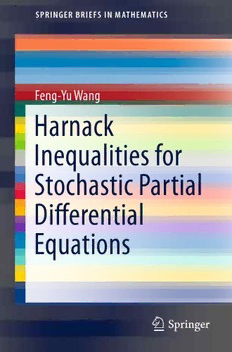Table Of ContentSPRINGER BRIEFS IN MATHEMATICS
Feng-Yu Wang
Harnack
Inequalities for
Stochastic Partial
Diff erential
Equations
123
SpringerBriefs in Mathematics
SeriesEditors
KrishnaswamiAlladi
NicolaBellomo
MicheleBenzi
TatsienLi
MatthiasNeufang
OtmarScherzer
DierkSchleicher
VladasSidoravicius
BenjaminSteinberg
YuriTschinkel
LoringW.Tu
G.GeorgeYin
PingZhang
SpringerBriefsinMathematicsshowcasesexpositionsinallareasofmathematics
andappliedmathematics.Manuscriptspresentingnewresultsorasinglenewresult
inaclassicalfield,newfield,oranemergingtopic,applications,orbridgesbetween
newresultsandalreadypublishedworks,areencouraged.Theseriesisintendedfor
mathematiciansandappliedmathematicians.
Forfurthervolumes:
http://www.springer.com/series/10030
Feng-Yu Wang
Harnack Inequalities
for Stochastic Partial
Differential Equations
123
Feng-YuWang
SchoolofMathematicalSciences
BeijingNormalUniversity
Beijing,China,People’sRepublic
DepartmentofMathematics
SwanseaUniversity
Swansea,UnitedKingdom
ISSN2191-8198 ISSN2191-8201(electronic)
ISBN978-1-4614-7933-8 ISBN978-1-4614-7934-5(eBook)
DOI10.1007/978-1-4614-7934-5
SpringerNewYorkHeidelbergDordrechtLondon
LibraryofCongressControlNumber:2013944370
MathematicsSubjectClassification(2010): 60H10,60H15,60H20
©Feng-YuWang2013
Thisworkissubjecttocopyright.AllrightsarereservedbythePublisher,whetherthewholeorpartof
thematerialisconcerned,specificallytherightsoftranslation,reprinting,reuseofillustrations,recitation,
broadcasting,reproductiononmicrofilmsorinanyotherphysicalway,andtransmissionorinformation
storageandretrieval,electronicadaptation,computersoftware,orbysimilarordissimilarmethodology
nowknownorhereafterdeveloped.Exemptedfromthislegalreservationarebriefexcerptsinconnection
with reviews or scholarly analysis or material supplied specifically for the purpose of being entered
and executed on a computer system, for exclusive use by the purchaser of the work. Duplication of
this publication or parts thereof is permitted only under the provisions of the Copyright Law of the
Publisher’slocation,initscurrentversion,andpermissionforusemustalwaysbeobtainedfromSpringer.
PermissionsforusemaybeobtainedthroughRightsLinkattheCopyrightClearanceCenter.Violations
areliabletoprosecutionundertherespectiveCopyrightLaw.
Theuseofgeneraldescriptivenames,registerednames,trademarks,servicemarks,etc.inthispublication
doesnotimply,evenintheabsenceofaspecificstatement,thatsuchnamesareexemptfromtherelevant
protectivelawsandregulationsandthereforefreeforgeneraluse.
Whiletheadviceandinformationinthisbookarebelievedtobetrueandaccurateatthedateofpub-
lication,neithertheauthorsnortheeditorsnorthepublishercanacceptanylegalresponsibilityforany
errorsoromissionsthatmaybemade.Thepublishermakesnowarranty,expressorimplied,withrespect
tothematerialcontainedherein.
Printedonacid-freepaper
SpringerispartofSpringerScience+BusinessMedia(www.springer.com)
Tomyparents,
ShoujinWangandGuijiaSang,
fortheir80thbirthdays
Preface
ThekeypointofHarnack’sinequalityistocomparevaluesattwodifferentpointsfor
positive solutions of apartialdifferentialequation. This inequality was introduced
byHarnack[21]in1887forharmonicfunctionsonaEuclideanspace,andwasgen-
eralized by Serrin [46] in 1955 and Moser [34] in 1961 to solutions of elliptic or
parabolicpartialdifferentialequations.Amongmanyotherapplications,Harnack’s
inequality was used by Li and Yau [26] in 1986 to derive explicit heat kernel es-
timates, and by Hamilton [20] in 1993 to investigate the regularity of Ricci flows,
whichwasthenusedinPerelman’sproofofthePoincare´ conjecture.AlltheseHar-
nackinequalitiesare,however,dimension-dependentandthusinvalidforequations
oninfinite-dimensionalspaces.
In this book we aim to present a self-contained account of Harnack inequali-
tiesandapplicationsforthesemigroupofsolutionstostochasticfunctional/partial
differentialequations.SincetheassociatedFokker–Planckequationsarepartialdif-
ferentialequationsoninfinite-dimensionalspaces,theHarnackinequalitiesweare
goingtoinvestigatearedimension-free.Thisisessentiallydifferentfromtheabove-
mentioned classical Harnack inequalities. Moreover, the main tool in our study is
anewcouplingmethod(i.e.,couplingbychangeofmeasure)ratherthantheusual
maximumprincipleintheliteratureofpartialdifferentialequations andgeometric
analysis.
The book consists of four chapters. In Chap.1, we introduce a general theory
concerning dimension-free Harnack inequalities, which includes the main idea of
establishingHarnackinequalitiesandderivativeformulasusingcouplingbychange
of measure, derivative formulas using the Malliavin calculus, links of Harnack in-
equalities to gradient estimates, and various applications of Harnack inequalities.
InChap.2,weestablishtheHarnackinequalitywithpowerandthelog-Harnackin-
equalityforthesemigroupassociatedtoaclassofnonlinearstochasticpartialdiffer-
ential equations, which include stochastic generalized porous media/fast-diffusion
equationsastypicalexamples.Themaintoolisthecouplingbychangeofmeasure
introduced in Chap.1. In Chap.3, we investigate gradient estimates and Harnack
inequalities for semilinear stochastic partial differential equations using coupling
by change of measure, gradient estimates, and finite-dimensional approximations.
vii
viii Preface
Chapter4isdevotedtogradientestimatesandHarnackinequalitiesforthesegment
solution of stochastic functional differential equations, using coupling by change
ofmeasureandtheMalliavincalculus.Tosavespace,applicationsofHarnackand
shift Harnack inequalities presented in Chap.1 are not restated in the other three
chaptersforspecificmodels.
Inthisbookweconsideronlystochasticfunctional/partialdifferentialequations
driven by Brownian motions. But the general theory introduced in Chap.1 works
also for stochastic differential equations driven by Le´vy noises or the fractional
Brownian motions; see [16,17,62,63,67,76] and references therein. Materials of
thebookaremainlyorganizedfromtheauthor’srecentpublications,includingjoint
paperswithcolleagueswhoaregratefullyacknowledgedforfruitfulcollaborations.
In particular, I would like to mention the joint work [3] with Marc Arnaudon and
Anton Thalmaier, where the coupling by change of measure was used for the first
timetoestablishthedimension-freeHarnackinequality.
I would like to thank Xiliang Fan and Shaoqin Zhang for reading earlier drafts
ofthebookandmakingcorrections.Iwouldalsoliketothankmycolleaguesfrom
the probability groups of Beijing Normal University and Swansea University, in
particularMu-FaChen,WenmingHong,NielsJacob,ZenghuLi,EugeneLytvynov,
YonghuaMao,AubreyTruman,Jiang-LunWu,ChengguiYuan,andYuhuiZhang.
Theirkindhelpandconstantencouragementprovidedmewithanexcellentworking
environment.
Finally, financial support from the National Natural Science Foundation of
China, Specialized Research Foundation for Doctoral Programs, the Fundamental
Research Funds for the Central Universities, and the Laboratory of Mathematics
andComplexSystemsaregratefullyacknowledged.
Beijing,China Feng-YuWang
Contents
1 AGeneralTheoryofDimension-FreeHarnackInequalities ......... 1
1.1 CouplingbyChangeofMeasureandApplications ............... 1
1.1.1 HarnackInequalitiesandBismutDerivativeFormulas ..... 2
1.1.2 ShiftHarnackInequalitiesandIntegrationbyParts
Formulas ........................................... 6
1.2 DerivativeFormulasUsingtheMalliavinCalculus............... 8
1.2.1 BismutFormulas .................................... 9
1.2.2 IntegrationbyPartsFormulas .......................... 11
1.3 HarnackInequalitiesandGradientInequalities .................. 12
1.3.1 Gradient–EntropyandHarnackInequalities .............. 12
1.3.2 FromGradient–GradienttoHarnackInequalities.......... 16
1.3.3 L2GradientandHarnackInequalities ................... 17
1.4 ApplicationsofHarnackandShiftHarnackInequalities .......... 20
1.4.1 ApplicationsoftheHarnackInequality .................. 20
1.4.2 ApplicationsoftheShiftHarnackInequality ............. 25
2 NonlinearMonotoneStochasticPartialDifferentialEquations ...... 27
2.1 SolutionsofMonotoneStochasticEquations.................... 27
2.2 HarnackInequalitiesforα≥1 ............................... 30
2.3 HarnackInequalitiesforα∈(0,1) ............................ 37
2.4 ApplicationstoSpecificModels .............................. 46
2.4.1 StochasticGeneralizedPorousMediaEquations .......... 46
2.4.2 Stochasticp-LaplacianEquations....................... 47
2.4.3 StochasticGeneralizedFast-DiffusionEquations.......... 48
3 SemilinearStochasticPartialDifferentialEquations ............... 51
3.1 MildSolutionsandFinite-DimensionalApproximations .......... 51
3.2 AdditiveNoise............................................. 57
3.2.1 HarnackInequalitiesandBismutFormula................ 57
3.2.2 ShiftHarnackInequalitiesandIntegrationbyParts
Formula............................................ 62
ix

